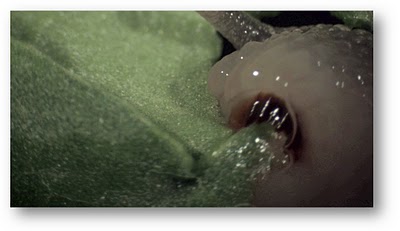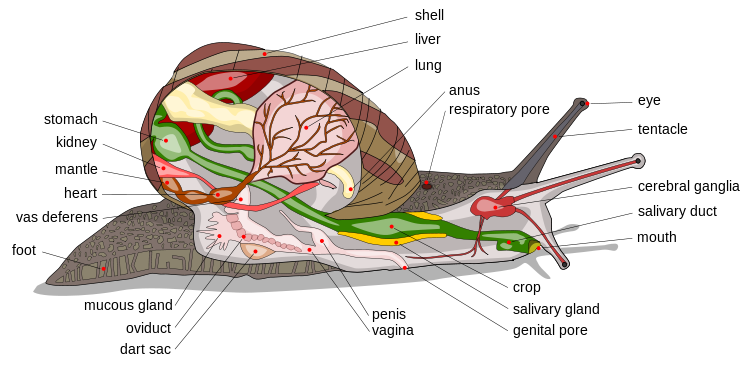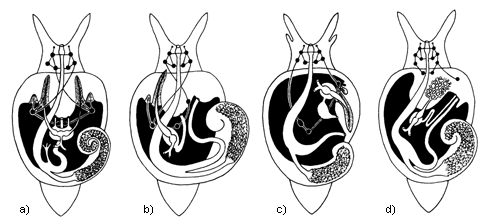
Adaptation
How did snails adapt to survive on land?
Mesodon mitchellianus adapted in many ways over the years. One of its adaptations is their teeth which are used for feeding. In order for the snail to feed on vegetation such as leaves, they have adapted mouths which allow them to break down their food easily.
Because M. mitchellianus is a pulmonate, it has a specialized structure made of chitin called a radula (Invertebrate Diversity, 2010). The radula is used to scrape food and cut through leafy material often consumed by these herbivores (Invertebrate Diversity, 2010). The teeth within the radula allow this scraping and tearing of their diet (Invertebrate Diversity, 2010).
There is much variation among the teeth of
snails even within the genus
Mesodon. There is little known about the mouth of Mesodon mitchellianus,
however we do know that
M. mitchellianus has an outer cusp and this is a defining
characteristic of its species (Binney, 1878).
This differs from M. thyroidus, which has no side cusp on
the outermost lateral teeth (Binney, 1878).
The outermost lateral teeth of M. thyroidus have a cutting
point that is long and slender (Binney 1878).
The cutting point is unusual in that it slants downward below
the base of their mouth (Binney 1878).
The first lateral teeth and central teeth of M. thyroidus lack cutting points, which is different from the
outermost lateral teeth, which posses a cutting point (Binney
1878). This cutting point is used primarily to scrape food and cut
through decaying leaves (Binney, 1878).
within the genus
Mesodon. There is little known about the mouth of Mesodon mitchellianus,
however we do know that
M. mitchellianus has an outer cusp and this is a defining
characteristic of its species (Binney, 1878).
This differs from M. thyroidus, which has no side cusp on
the outermost lateral teeth (Binney, 1878).
The outermost lateral teeth of M. thyroidus have a cutting
point that is long and slender (Binney 1878).
The cutting point is unusual in that it slants downward below
the base of their mouth (Binney 1878).
The first lateral teeth and central teeth of M. thyroidus lack cutting points, which is different from the
outermost lateral teeth, which posses a cutting point (Binney
1878). This cutting point is used primarily to scrape food and cut
through decaying leaves (Binney, 1878).
Many adaptations had to occur in order to allow
the snail to be able to live in terrestrial environments.
One significant adaptation is the development of the lung. M. mitchellianus is a pulmonate meaning that it has a
lung and is able to breathe air (Invertebrate
Diversity, 2010).
Pulmonate comes from the Greek word pulmanata meaning lung
(Invertebrate Diversity, 2010). The gill is not present because it is no
longer lives in marine or freshwater environments (Gastropoda,
2002).
The lung is contained in the mantle cavity (Gastropoda,
2002).
The mantle cavity
is modified and has a little opening called the pneumostome and many
blood vessels allowing for gas exchange to take place (Gastropoda,
2002). The air
enters the shell via the pneumostome when the mantle floor
contracts (Gastropoda, 2002). The pressure
within the mantle increases allowing for the oxygen to be easily
absorbed by the blood vessels and the pressure is then released and
carbon dioxide is pushed out (Gastropoda,
2002).
The ability to breath air allows for the snail to survive in
terrestrial environments.

The
class Gastropoda went through many
evolutionary changes involving their shell structure. The shell of
the gastropods before the torsion occurred was symmetric and coiled
in a flat plane making it difficult for them to move because of the
large and heavy shell (Gastropoda, 2002).
Then the gastropods went through torsion, which is an evolutionary
change where their body twisted 180 degrees (Gastropoda,
2002).
This then allows the shell
to coil along a central axis at a slant creating an asymmetrical
shell (Gastropoda, 2002).
This helped to distribute the weight, create more balance, and allow
the gastropod to move more easily
